| ILFORD Sporti, from 1959 |
 |
| Picture by PCCI member John Dodkins using his Canon 5D. The lighting set-up was by 'Dunk'. |
|
|
||
|
The Ilford Sporti camera range was contemporary to the Sportsman, though first appearing somewhat later than the first Sportsman, perhaps spring 1959 for the first model. It was made by Dacora, in Germany and used the still very popular, at that time, roll film format. It was aimed at the junior, more inexperienced, or just plain 'snapshot' photographer. The first to appear was the Sporti, as above. Despite being styled to look like a 35mm camera, it took 12 pictures on 120 size roll-film. Focussing settings were marked for close-ups, groups and views, with an exposure control marked for cloudy and sunny lighting conditions. It was synchronised for flash. Fitted with an accessory shoe and optical viewfinder within the top plate, being "a pressing finished in aluminium enamel which resembles satin finish chrome". Price in 1959-60 (from the Wallace Heaton Blue Book) was £3.17s.7d (77s.7d as spoken by Ilford in the mp3 files from Paul Rumbol, see below = £3.88p) with an Ever-ready case costing £1.1s.10d extra (£1.09p). Wallace Heaton also charged 2/- (10p) post and packing. In 1962 the Sporti cost £3.18s.8d (£3.93p). Click on the icon for a pdf
file of the Sporti instruction booklet. |
||
|
Below are images from 120 roll film colour transparencies, taken using a Sporti. The transparencies were scanned by John Dodkins. Another Sporti image can be seen on this page, of A.R. 'Pip' Pippard, taken by his son Jon, then aged 9 in 1964. |
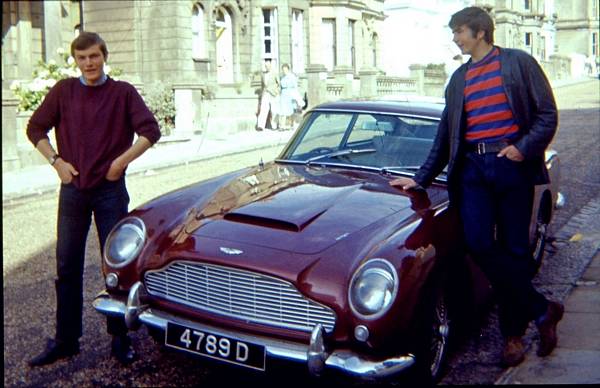 |
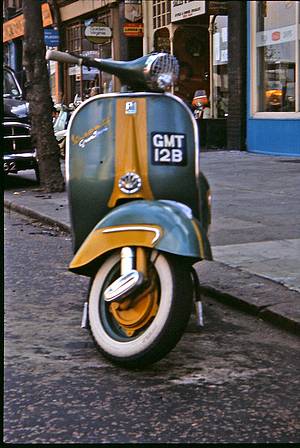 |
|
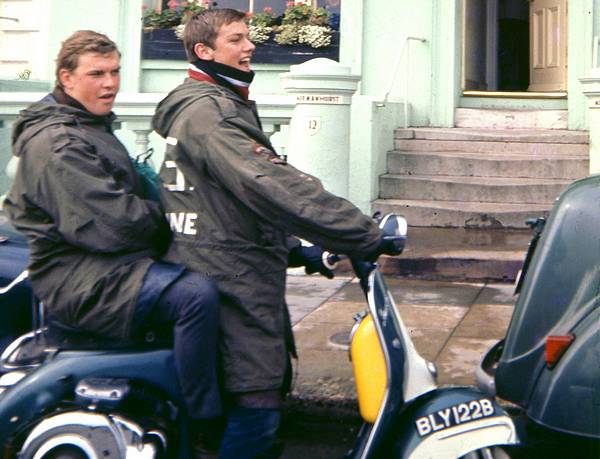 |
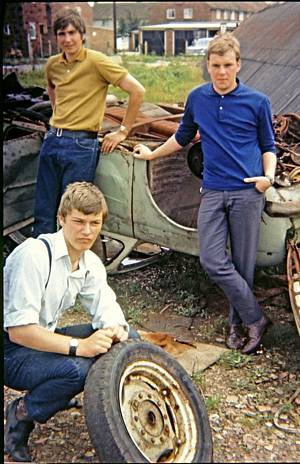 |
|
| Raijo Lauro, in Finland, has an excellent site with many makes of camera and other photographic items described and beautifully illustrated. If you are interested in the Ilford Sporti, do take a look at his web page. |
|
Although nominally identical, the left hand model has a silver metal wind-on knob while the right hand version has a white plastic knob, so may date to slightly later. |
|
The Sporti was soon joined (the BJPA for 1961 says the original Sporti continued to be available, initially) by the Super Sporti which looked very similar but had a few extra refinements (a 'Cloudy-Dull' aperture setting, a Bulb shutter timing and double exposure prevention). It took 12 pictures 6cm square on 120 roll film. The Super Sporti instruction booklet is normally available at http://yandr.50megs.com/ilford/ss/ss.htm (may be temporarily disabled for reasons unknown). |
|
|
|
The Wallace Heaton Blue Book for 1961-62 describes the Super Sporti as having a metal body, with an eyelevel viewfinder and body release. Exposure control was via aperture settings for 'Sunny', 'Light Cloud' and 'Dull' and I(nstantaneous) + B(ulb) shutter timings. The 'Sunny' and 'Light Cloud' settings were obtained via changes in the size of aperture opening (f11 to f9); simple holes in a metal plate, sliding behind the simple meniscus lens. The 'Dull' setting used the same f9 aperture as 'Light Cloud' but also changed the shutter speed to a slower value (1/25th in place of 1/50th ?) and this same exposure setting was also used for 'Flash'. There was double exposure prevention, an accessory shoe and standard coaxial flash synchronisation contacts. Focussing was marked for 'Close-ups' (5-10ft), 'Groups' (10 to 25ft) and 'Views'. The price of the Super Sporti in 1961-62 was £5.12s.6d (£5.63p) with standard and de-luxe cases at £1.1.10d and £1.9s.1d (£1.09p & £1.45p) respectively. |
|
This underside view of the Super Sporti (see right) shows the tripod bush, the coaxial 'PC' flash connector and the sliding back release. The chamber for the unexposed roll film (see below, LHS) hinges outwards for ease of inserting the spool. The wind-on knob lifts and the lower film locating pin also hinges outwards (see below, RHS). The retained back opens on a hinge. Inside can be seen the usual Ilford 'silent salesman' sticker, this one saying "Always Use ILFORD 120 FILMS, Summer: Selochrone Pan, Winter: HP3". |
|
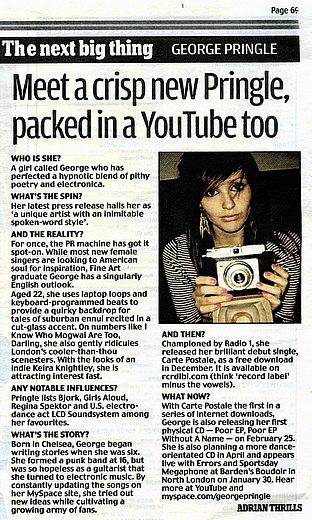 |
The picture alongside (left), from the Daily Mail around 10th January 2008, shows the enduring affection shown to the Ilford Sporti. The girl holding a Sporti (or maybe a Super Sporti) is George Pringle, a current new talent on the pop scene. The Daily Mail text, by Adrian Thrills, is legible, so those with an interest in these things can read more for themselves. (Right) A Sporti
Gift Set for Christmas, as advertised by Ilford Ltd on the back
cover of Photography magazine for December 1961. |
|
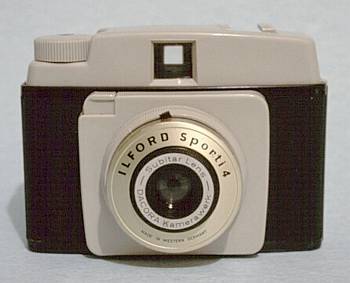 The Sporti 4 and Sporti 6 (see below) were an attempt to improve market share by reducing price through the use of a high impact polystyrene plastic body construction. The Sporti 4 was first available in 1960. |
It was intended for a youngster, as illustrated by this 1960 Meccano magazine advert. The Subitar meniscus fixed focus lens (8ft - infinity) offered just one adjustment, 'sunny' or 'cloudy'. The single speed shutter was flash synchronised and the camera was equipped with an accessory shoe and tripod bush. Wallace Heaton advertised the Sporti 4 at £2.10s.5d (£2.52p) in 1961-62 (a small increase over the original price), with a case 17s/5d (88p) extra. |
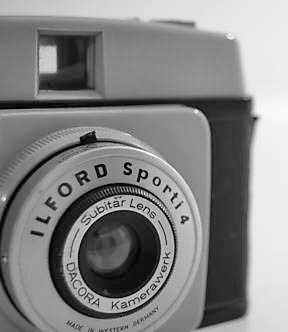 |
 |
|
In 1962 the Sporti '4' cost £2.9s.8d (£2.48p). A 1.5MB pdf file of the Sporti
4 instruction booklet can be dowloaded here |
|
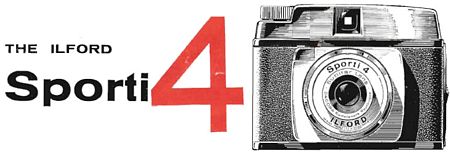 |
ILFORD PhotoNews for June 1960 advertised the Sporti 4: Here is a new Ilford roll film camera for the younger members of the family or anyone who wants superb snapshots with the minimum of fuss. A really great little camera, the Sporti 4 is in the same value-for-money class as the Sporti and the Super Sporti. Priced at only 49/8d., it takes twelve pictures, 1&5/8 inches square on 127 film. The quality of the fixed-focus lens is such that it will give really pin-sharp pictures at any distance from 8 feet to infinity. |
| The Sporti 4 is
an all-the-year-round camera, too. Load it with Selochrome Pan
film in summer or HP3 in winter, set it to 'Sunny' or 'Cloudy'
according to the weather . . . and away you go! No worries about
shutter speeds, f/ numbers or focusing—what you see through
the big optical eye-level viewfinder you will get on your print. What is more, the Sporti 4 does not restrict you to outdoor snapshots. The single-speed shutter is synchronised for flash and there is an accessory shoe on top of the camera to take a flashgun, such as the llford Sportilux. All in all, the Sporti 4 is a joy to look at and a joy to use. Its smart, two-toned body is styled in the modern manner and fits comfortably in the hands. The film-wind knob is flush with the top of the camera, and the press-button shutter release is fitted into the top left-hand corner of the lens panel. The body of the camera is covered with black leatherette and the exposed metal parts are finished in silvergrey. ALL THIS FOR 49/8d.! (Ever-ready case 17/5d). |
|
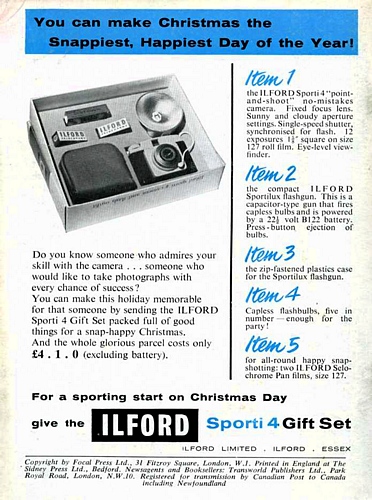 |
The Sporti 4 Christmas Gift Outfit, as advertised on the back cover of PhotoGuide magazine for December 1960. The Sporti 4, complete with Sportilux flashgun, flashgun case, 2 rolls of 127 size Selochrome Pan film and five flash bulbs, cost £4.1s (£4.5p). By December 1962 the price had reduced to £3.10s.3d (£3.51p). Interestingly, there is no flashgun battery included, whereas in the Sporti Gift Outfit advertised in December 1961, a battery is included. Perhaps Ilford learned a lesson after this 1960 advert that shops are shut on Christmas day and excited youngsters are not happy having to wait for shops to open again so they (or their parents) can buy them a battery. By December 1962, both gift sets contained a battery ! |
|
|
These pictures (left and above) are courtesy of David Muggleton. They show the box in which the original Sporti 4 case was sold. The case is shown above. The colour scheme on the box is similar to that on the cover of the instruction manual and may well be the same as on the box in which the Sporti 4 camera was sold. |
|
|
The Sporti 6 produced 12 off 6cm square negatives on 120 roll film, the same as the original Sporti. Made by Dacora in W.Germany and constructed of black plastic and bright metal, it was introduced in December 1963. It was more sophisticated than the Sporti 4 by including more user adjustments for exposure, namely three apertures f 8, f11 & f16 and a two speed shutter providing 1/50th and 1/100th second, plus flash synchronisation. By a combination of its shape, appearance, its mock selenium cell exposure meter to the left of the viewfinder window and its lever wind for moving on the roll film to its next exposure (though the film exposure number needed to be manually aligned into the rear red window, as normal with roll film), gave the impression of a more expensive camera than it actually was. It tried to impersonate an automatic 35mm film camera, e.g. the Sportsman Auto. A 1.1MB pdf file of the Sporti
6 instruction booklet can be downloaded here |
|
|
Focussing was by a scale marked with symbols, metres and feet. The symbols are 'head & shoulders', corresponding to 1.5-3m or 5-10feet, a group of people, corresponding to 3-8metres or 10-25feet, and a scene of hills & trees, corresponding to 8m to infinity, or 25feet to infinity. The lens is a two element achromat of f8 aperture, made by Dacora Kamerawerk, Reutlingen. The top toggle lever, situated above the top centre distance marking above the lens, varies the aperture from f8, to f11 and f16 using three fixed diameter 'stops' behind the lens, linked to the toggle lever. The shutter speed is selected by moving the black serrated lens surround collar, behind the silver coloured distance scale. A white line selects either the 1/50th or 1/100th second speed. The 1/50th speed is also marked with the conventional red lightning symbol, indicating that this speed should be selected when using flash. The shutter release is the black protrusion to the upper left of the lens and is fired by presssing it inwards, towards the camera body. |
| The shutter speed selection collar, when viewed from below, can be seen to partly mask the flash synchronisation socket (a standard PC type) when in the 1/100th second speed selection position (see left). When the collar is rotated to select the correct (for flash) 1/50th second speed, a cut-out lines up with the flash synchronisation socket, enabling its use (see far left picture). | |
|
|
The top and rear of the Sporti 6 are plain apart from the top accessory shoe (for mounting a flash gun), a lever wind (unusual for roll film), the rear sight for the simple viewfinder and a rear mounted 'red window' for observing the numbers (1 to 12) on the back of the roll film. The wind-on lever simply takes the place of the more conventional wind-on knob, but the user still needs to observe the film backing paper through the rear red window and actuate the lever until the next exposure number is centred in the window. There is no automatic linking of the amount of movement of the lever wind with the movement of the film to the next exposure. |
| The shutter mechanism is interlocked with the shutter release to (in part) prevent double exposures. The need to wind on the film is indicated by a small red square to the left of the viewfinder, see the picture, far left. When the lever wind is used, the red square disappears (see left) and the shutter can be fired. But it would be possible to fire the shutter without the film being wound on sufficiently to avoid a partial double exposure. | |
|
|
The base of the Sporti 6 has a standard tripod bush and a sliding metal catch to unlatch the back, which comes completely off - there is no retaining hinge. The back retaining latch is marked in German 'AUF' and 'ZU' and also in English 'open' and 'lock'. |
|
Inside, with the back removed, can be seen the matt black painted film exposure chamber, with the spring retaining film chambers either side. The shutter is a simple sliding metal plate behind the lens. The film follows a curved path across the exposure chamber to provide some correction for lens curvature of field in the one plane. |
|
|
|
The black plastic back with its red window and, in its base, the sliding metal back latch. Also, note the Ilford 'silent salesman', advising "Always use ILFORD 120 FILMS, Selochrome Pan for black & white, Ilfocolor for colour". Light sealing is by inter-locking the edge of the back with channels around the rear of the camera body. No light sealing fabric used. |
|
This page last modified: 29th August 2014 |
|

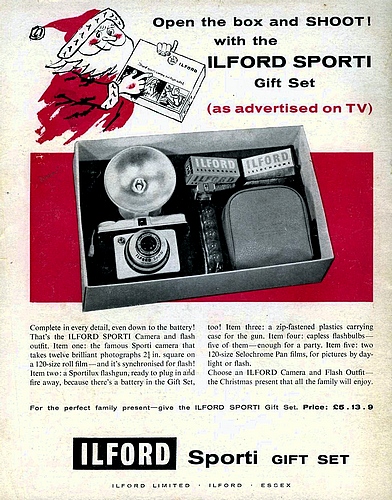
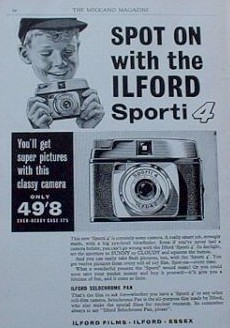 The Sporti '4' took 12 pictures 4cm
square on 127 roll film,
The Sporti '4' took 12 pictures 4cm
square on 127 roll film,